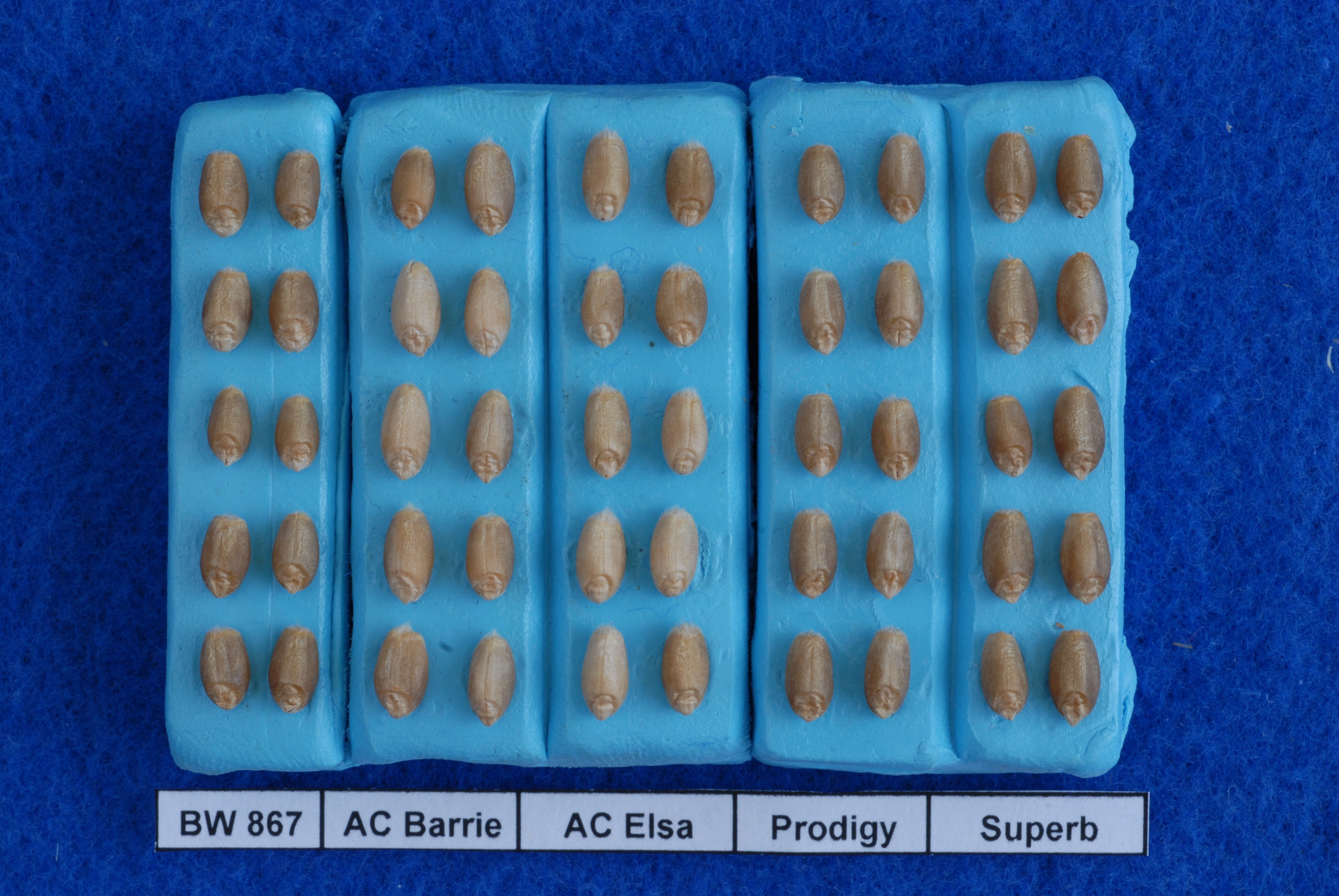Stettler
| Denomination: | 'Stettler' |
|---|---|
| Previously Proposed Denomination: | 'BW867' |
| Botanical Name: | Triticum aestivum |
| Applicant/Holder: |
Agriculture & Agri-Food Canada, Swift Current Research and Development Centre 1 Airport Road P.O. Box 1030 Swift Current, Saskatchewan S9H 3X2 Canada |
| Breeder: |
Ron De Pauw, Agriculture & Agri-Food Canada, Swift Current, Saskatchewan |
| Agent in Canada: |
Agriculture & Agri-Food Canada Office of Intellectual Property and Commercialization c/o Shannon Whyte 107 Science Place Saskatoon, Saskatchewan S7N 0X2 Canada Tel: (204) 999-9887 |
| Application Date: | 2008-04-24 |
| Application Number: | 08-6306 |
| Grant of Rights Date: | 2010-05-21 |
| Certificate Number: | 3838 |
| Grant of Rights Termination Date: | 2028-05-21 |
Variety Description
Varieties used for comparison: 'AC Barrie', 'AC Elsa', 'Infinity', 'Prodigy' and 'Superb'
Summary: 'Stettler' has weaker anthocyanin colouration of the coleoptile than 'Superb'. The growth habit of 'Stettler' is semi-erect whereas it is intermediate for 'AC Barrie' and 'Infinity'. 'Stettler' has fewer plants with recurved/drooping flag leaves than 'AC Barrie'. The anthocyanin colouration of the flag leaf auricles is weaker in 'Stettler' than it is in 'Superb'. 'Stettler' has a shorter plant height than 'AC Barrie', 'Infinity' and 'Prodigy'. The lower glumes of 'Stettler' are shorter than those of 'AC Barrie', 'Infinity' and 'Superb'. 'Stettler' has longer spikes than 'AC Barrie', 'AC Elsa', 'Prodigy' and 'Superb'. 'Stettler' has smaller kernels than 'Superb'. The germ size of 'Stettler' is larger than it is in 'AC Elsa'. The shape of the germ for 'Stettler' is rounded whereas it is oval for 'Infinity', 'Prodigy' and 'Superb'. 'Stettler' shows more resistance to Fusarium head blight than 'AC Elsa' and 'Infinity'. Resistance to common bunt in 'Stettler' is higher than in 'AC Elsa'. 'Stettler' shows more resistance to loose smut than 'AC Barrie', 'Prodigy' and 'Superb'. Resistance to leaf rust in 'Stettler' is higher than in 'AC Barrie' and 'Superb', but lower than in 'AC Elsa' and 'Infinity'.
Description:
PLANT: spring type, semi-erect growth habit
SEEDLING: weak to medium intensity of anthocyanin colouration of coleoptile, sparse pubescence on lower leaf sheaths, sparse pubescence on lower leaf blades
FLAG LEAF: low to medium frequency of plants with recurved/drooping flag leaves, glabrous blades and sheaths, absent or very weak anthocyanin colouration of auricles, medium glaucosity of sheath
CULM NECK: medium glaucosity, weak curvature
STRAW: thin pith in cross section, very weak to weak anthocyanin colouration at maturity
SPIKE: parallel sided shape, medium density, incline attitude and white at maturity, weak to medium glaucosity, white awns present, strongly spreading awn attitude
LOWER GLUME: narrow to medium width, medium to long, glabrous pubescence, predominantly straight shape of shoulder, predominantly narrow shoulder, predominantly slightly curved beak, predominantly short beak
KERNEL: hard red type, red, small to medium sized kernel, oval to ovate shape, angular cheek shape, medium length brush hairs, medium to wide crease, shallow to medium deep crease
GERM: round shape, large
AGRONOMY: good resistance to shattering, drought and pre-harvest sprouting
DISEASE RESISTANCE: moderately susceptible to Fusarium head blight (Fusarium graminearum, Fusarium species), moderately resistant to Common bunt (Tilletia caries, Tilletia foetida), resistant to Loose smut (Ustilago tritici), moderately susceptible to Leaf rust (Puccinia triticina) and resistant to Stem rust (Puccinia graminis f.sp. tritici)
Origin & Breeding History: 'Stettler' (experimental designation BW867) originated from the cross made in 1999 between 'Prodigy' and 'Superb' near Swift Current, Saskatchewan. Seed of individual doubled haploid lines was inoculated with common bunt. Spikes were selected from the disease resistant doubled haploid lines that also matured early and had strong stems of acceptable height and were grown near Irwell, New Zealand. Agronomic performance was assessed in nurseries near Swift Current, Regina, Indian Head (Saskatchewan), Lethbridge (Alberta) and Morden (Manitoba). Doubled haploid lines were screened for reaction to leaf rust, stem rust, loose smut and common bunt and resulted in an experimental doubled line B9962&AR12 being identified. This experimental line was evaluated from 2003 to 2007 in the Western bread Wheat Cooperative. It received registration No. 6516 from the Variety Registration Office, Plant Production Division, Canadian Food Inspection Agency on 2008, October 16 and named 'Stettler'.
Tests & Trials: Test and trials for 'Stettler' were conducted during the summers of 2007 and 2008 in Swift Current, Saskatchewan. Plots consisted of 4 rows with a row spacing of 23 centimeters with a seeding rate of 220 seeds per meter square. There were 4 replicates.
Comparison tables for 'Stettler' with reference varieties 'AC Barrie', 'AC Elsa', 'Infinity', 'Prodigy' and 'Superb'
Plant height (including awns) (cm)
| 'Stettler' | 'AC Barrie' | 'AC Elsa' | 'Infinity' | 'Prodigy' | 'Superb' | |
|---|---|---|---|---|---|---|
| mean | 90.3 | 94.6 | 94.1 | 97.3 | 101.0 | 91.6 |
| std. deviation | 3.6 | 2.2 | 3.3 | 4.8 | 3.5 | 2.4 |
Lower glume length (mm)
| 'Stettler' | 'AC Barrie' | 'AC Elsa' | 'Infinity' | 'Prodigy' | 'Superb' | |
|---|---|---|---|---|---|---|
| mean | 7.4 | 7.9 | 7.4 | 8.2 | 7.6 | 8.1 |
Click on image for larger view

Wheat: 'Stettler' (BW 867) (left) with reference varieties 'AC Barrie' (centre left), 'AC Elsa' (centre), 'Prodigy' (centre right), and 'Superb' (right).
- Date modified: